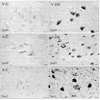Life-long overexpression of S100beta in Down's syndrome: implications for Alzheimer pathogenesis
- PMID: 9880042
- PMCID: PMC3833593
- DOI: 10.1016/s0197-4580(98)00074-8
Life-long overexpression of S100beta in Down's syndrome: implications for Alzheimer pathogenesis
Abstract
Chronic overexpression of the neurite growth-promoting factor S100beta has been implicated in the pathogenesis of neuritic plaques in Alzheimer's disease. Such plaques are virtually universal in middle-aged Down's syndrome, making Down's a natural model of Alzheimer's disease. We determined numbers of astrocytes overexpressing S100beta, and of neurons overexpressing beta-amyloid precursor protein (beta-APP), and assayed for neurofibrillary tangles in neocortex of 20 Down's syndrome patients (17 weeks gestation to 68 years). Compared to controls, there were twice as many S100beta-immunoreactive (S100beta+) astrocytes in Down's patients at all ages: fetal, young, and adult (p = 0.01, or better, in each age group). These were activated (i.e., enlarged), and intensely immunoreactive, even in the fetal group. There were no neurofibrillary changes in fetal or young Down's patients. The numbers of S100beta+ astrocytes in young and adult Down's patients correlated with the numbers of neurons overexpressing beta-APP (p < 0.05). Our findings are consistent with the idea that conditions--including Down's syndrome--that promote chronic overexpression of S100beta may confer increased risk for later development of Alzheimer's disease.
Figures






References
-
- Allore R, O’Hanlon D, Price R, Neilson K, Willard HF, Cox DR, Marks A, Dunn RJ. Gene encoding the β subunit of S100 protein is on chromosome 21: Implications for Down syndrome. Science. 1988;239:1311–1313. - PubMed
-
- Barger SW, Van Eldik LJ. S100β stimulates calcium fluxes in glial and neuronal cells. J. Biol. Chem. 1992;267:9689–9694. - PubMed
-
- Bhattacharyya A, Oppenheim RW, Prevette D, Moore BW, Brackenbury R, Ratner N. S100 is present in developing chicken neurons and Schwann cells and promotes neuron survival in vivo. J. Neurobiol. 1992;23:451–466. - PubMed
-
- Cork L. Neuropathology of Down syndrome and Alzheimer disease. Am. J. Med. Gen. 1990;7:282–286. - PubMed
-
- da Cunha A, Jefferson JJ, Tyor WR, Glass JD, Jannotta FS, Vitkovic L. Gliosis in human brain: Relationship to size but not other properties of astrocytes. Brain Res. 1993;600:161–165. - PubMed
Publication types
MeSH terms
Substances
Grants and funding
LinkOut - more resources
Full Text Sources
Medical

